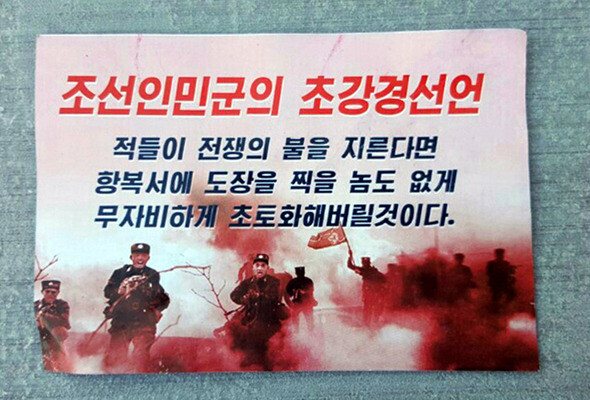hankyoreh
Links to other country sites 다른 나라 사이트 링크
Pyongyang continues low-intensity response to loudspeaker propaganda

On Jan. 14, the North Korean military once again sent propaganda leaflets into South Korea. Along with scattering the leaflets and dispatching a drone on Wednesday, this is part of what constitutes a low-intensity response by Pyongyang. The approach is quite different from last August, when the North responded more forcefully to South Korean propaganda broadcasts from loudspeakers on the DMZ - with an artillery barrage.
“Our military confirmed that North Korea once again distributed leaflets last night and early this morning around the same areas as the previous day,” said Jeon Ha-gyu, press officer for South Korea’s Joint Chiefs of Staff, during the regular briefing on Thursday. The content of the leaflets was reportedly similar to the previous day, criticizing South Korean President Park Geun-hye and calling for an end of the loudspeaker broadcasts.
On Wednesday, Jeon said that the army had collected tens of thousands of leaflets. While Jeon did not disclose how many leaflets North Korea distributed the second time, sources said it was about the same as the day before.
As of yet, there are no clear indications that the North Korean armed forces will take military action or any other kind of high-intensity response.
“While there are some movements among North Korea’s artillery units, these are the customary winter exercises, and there are no signs of an impending provocation,” said Kim Min-seok, spokesperson for South Korea’s Ministry of National Defense.
This is different from the attitude adopted by North Korea when South Korea reactivated the loudspeakers on the DMZ after the landmine incident in the DMZ in Aug. 2015.
On Aug. 14, four days after South Korea resumed the propaganda broadcasts, North Korea sent a message describing the move as a “military provocation.” On Aug. 20, ten days after the broadcasts resumed, the North threatened that it would initiate military action if the loudspeakers were not removed within 48 hours.
One explanation offered for the difference in behavior is the fact that North Korea faces a storm of criticism from the international community after its fourth nuclear test.
Pyongyang has already gotten what it wanted from the test. The North Korean leaders may have concluded that, with the international community - and in particular the UN Security Council - already discussing sanctions against North Korea, taking military action against South Korea could provoke a backlash.
Another possibility is that, if North Korea seems oversensitive to the loudspeaker broadcasts, it could reinforce the impression that the broadcasts are North Korea’s Achilles’ heel.
Other analysts think that North Korea may be unsure whether the kind of high-intensity steps that it took in Aug. 2015 will work this time, which could lead it to keep up a series of low-intensity responses while waiting for a chance to turn the tables.
But since the South Korean military believes there is a high likelihood that North Korea will eventually began to take action to force the South to stop the broadcasts, it is remaining vigilant.
“Since the propaganda broadcasts will have a greater effect as more time passes, North Korea can’t just ignore them,” a senior South Korean military official said. “North Korea might switch to a more active response with the release of the upcoming UN sanctions or with the onset of the US-ROK Key Resolve joint exercises in February and March.”
By Park Byong-su, senior staff reporter
Please direct questions or comments to [english@hani.co.kr]

Editorial・opinion
![[Column] Is Korean democracy really regressing? [Column] Is Korean democracy really regressing?](https://flexible.img.hani.co.kr/flexible/normal/500/300/imgdb/original/2024/0705/2917201664129137.jpg) [Column] Is Korean democracy really regressing?
[Column] Is Korean democracy really regressing?![[Column] How tragedy pervades weak links in Korean labor [Column] How tragedy pervades weak links in Korean labor](https://flexible.img.hani.co.kr/flexible/normal/500/300/imgdb/original/2024/0703/8717199957128458.jpg) [Column] How tragedy pervades weak links in Korean labor
[Column] How tragedy pervades weak links in Korean labor- [Column] How opposing war became a far-right policy
- [Editorial] Korea needs to adjust diplomatic course in preparation for a Trump comeback
- [Editorial] Silence won’t save Yoon
- [Column] The miscalculations that started the Korean War mustn’t be repeated
- [Correspondent’s column] China-Europe relations tested once more by EV war
- [Correspondent’s column] Who really created the new ‘axis of evil’?
- [Editorial] Exploiting foreign domestic workers won’t solve Korea’s birth rate problem
- [Column] Kim and Putin’s new world order
Most viewed articles
- 110 days of torture: Korean mental patient’s restraints only removed after death
- 2Months after outcry over “torture devices,” Justice Ministry proposes more restraints for immigratio
- 3Beleaguered economy could stymie Japan’s efforts to buoy the yen
- 4[Column] Is Korean democracy really regressing?
- 5Koreans are getting taller, but half of Korean men are now considered obese
- 6[Column] How tragedy pervades weak links in Korean labor
- 7Former bodyguard’s dark tale of marriage to Samsung royalty
- 8Real-life heroes of “A Taxi Driver” pass away without having reunited
- 9[Editorial] Exploiting foreign domestic workers won’t solve Korea’s birth rate problem
- 10Democrats ride wave of 1M signature petition for Yoon to be impeached